Advertising Innovative Sustainable Fashion: Informational, Transformational, or Sustainability Appeal?
Abstract
1. Introduction
2. Theoretical Background
2.1. Informational, Transformational, and Sustainability Appeals in Online Fashion Advertising
2.2. Consumer Decision-Making Style
2.3. The Present Study
3. Materials and Methods
3.1. Sample and Procedure
3.2. Measures
3.3. Data Analysis
4. Results
4.1. Preliminary Analysis
4.2. Message Evaluation
4.3. Effects of Messages on Intention and Willingness to Buy the Bag Prototype
4.4. Effects of Messages on Intention as a Function of Participants’ Decision-Making Style
4.4.1. Perfectionist Consumers
4.4.2. Novelty-Fashion-Seeking Consumer
4.4.3. Hedonic Consumers
4.4.4. Green Consumers
5. Discussion
Limitations and Future Directions
6. Conclusions
Author Contributions
Funding
Institutional Review Board Statement
Informed Consent Statement
Data Availability Statement
Conflicts of Interest
References
- Eder Hansen, J.; Chalmer, C.; Tärneberg, S.; Tochtermann, T.; Seara, J.; Boger, S.; Jäger, K. Pulse of the fashion industry. Cph. Glob. Fash. Agenda 2017, 2, 31. [Google Scholar]
- United Nations Climate Change. Available online: https://unfccc.int/news/un-helps-fashion-industry-shift-to-low-carbon (accessed on 6 September 2018).
- Lundblad, L.; Davies, I.A. The values and motivations behind sustainable fashion consumption. J. Consum. Behav. 2016, 15, 149–162. [Google Scholar] [CrossRef]
- Milano Finanza Fashion. Available online: https://www.mffashion.com/news/livestage/il-fashion-green-varra-8-25-miliardi-nel-2023-202102151713285181 (accessed on 29 April 2022).
- Smith, P. Global Revenue of the Apparel Market 2014–2027. Available online: https://www.statista.com/forecasts/821415/value-of-the-global-apparel-market (accessed on 29 April 2022).
- Claxton, S.; Kent, A. The management of sustainable fashion design strategies: An analysis of the designer’s role. J. Clean. Prod. 2020, 268, 122112. [Google Scholar] [CrossRef]
- Belch, G.E.; Belch, M.A. Advertising and Promotion: An Integrated Marketing Communications Perspective, 9th ed.; Irwin/McGraw-Hill: New York, NY, USA, 2012. [Google Scholar]
- Bruce, N.I.; Murthi, B.P.S.; Rao, R.C. A dynamic model for digital advertising: The effects of creative format, message content, and targeting on engagement. J. Mark. 2017, 54, 202–218. [Google Scholar] [CrossRef]
- Dens, N.; De Pelsmacker, P. How advertising strategy affects brand and USP recall for new brands and extensions. Int. J. Advert. 2020, 29, 165–194. [Google Scholar] [CrossRef]
- Lwin, M.; Phau, I. Effective advertising appeals for websites of small boutique hotels. J. Res. Interact. Mark. 2013, 7, 18–32. [Google Scholar] [CrossRef]
- Lwin, M.; Phau, I.; Huang, Y.A.; Lim, A. Examining the moderating role of rational-versus emotional-focused websites: The case of boutique hotels. J. Vacat. Mark. 2014, 20, 95–109. [Google Scholar] [CrossRef]
- Testa, D.S.; Bakhshian, S.; Eike, R. Engaging consumers with sustainable fashion on Instagram. J. Fash. Mark. Manag. 2021, 25, 569–584. [Google Scholar] [CrossRef]
- Pérez-Curiel, C.; Sanz-Marcos, P. Branding, influencers and new targets in the communication of fashion and luxury. Prism. Soc. 2019, 24, 1–24. [Google Scholar]
- Castillo-Abdul, B.; Bonilla-del-Río, M.; Núñez-Barriopedro, E. Influence and relationship between branded content and the social media consumer interactions of the luxury fashion brand Manolo Blahnik. Publications 2021, 9, 10. [Google Scholar] [CrossRef]
- Castillo-Abdul, B.; Pérez-Escoda, A.; Núñez-Barriopedro, E. Promoting social media engagement via branded content communication: A fashion brands study on Instagram. Media Commun. 2022, 10, 185–197. [Google Scholar] [CrossRef]
- Kemp, S. Digital 2021: Global Digital Overview; We Are Social: 2021. Hootsuite, 2021. [Google Scholar]
- Belch, G.E.; Belch, M.A.; Kerr, G.F.; Powell, I. Advertising and Promotion: An Integrated Marketing Communications Perspective, 10th ed.; McGraw-Hill: Sydney, Australia, 2008. [Google Scholar]
- Cutler, B.D.; Thomas, E.G.; Rao, S.E. Informational/transformational advertising: Differences in usage across media types, product categories, and national cultures. J. Int. Consum. Mark. 2000, 12, 69–83. [Google Scholar] [CrossRef]
- Kleiser, S.B.; Baker, J.; Yorkston, E. Using transformational appeals to enhance the retail experience. J. Retail. 2018, 84, 49–57. [Google Scholar] [CrossRef]
- Cadet, F.T.; Aaltonen, P.G.; Kavota, V. The advertisement value of transformational & informational appeal on company Facebook pages. Mark. Manag. J. 2017, 27, 116–130. [Google Scholar]
- Chang, H.H.; Chen, F.P.; Fang, W.C. The Role of Regulatory Focus in Persuasion of Informational Appeal and Transformational Appeal. J. Bus. Adm. 2016, 109, 55–74. [Google Scholar]
- Gross, J.; von Wangenheim, F. Influencer Marketing on Instagram: Empirical Research on Social Media Engagement with Sponsored Posts. J. Interact. Mark. 2022, 22, 1–22. [Google Scholar] [CrossRef]
- Park, C.W.; Jaworski, B.J.; Maclnnis, D.J. Strategic brand concept-image Management, J. Mark. 1986, 50, 135–145. [Google Scholar] [CrossRef]
- Keller, K.L. Conceptualizing, measuring, and managing customer-based brand equity. J. Mark. 1993, 57, 1–22. [Google Scholar] [CrossRef]
- Ambler, T.; Burne, T. The impact of affect on memory of advertising . J. Mark. Res. 1999, 39, 25–34. [Google Scholar]
- Yoo, C.; MacInnis, D. The brand attitude formation process of emotional and informational ads. J. Bus. Res. 2005, 58, 1397–1406. [Google Scholar] [CrossRef]
- Cuesta-Valiño, P.; Gutiérrez-Rodríguez, P.; Núnez-Barriopedro, E. The role of consumer happiness in brand loyalty: A model of the satisfaction and brand image in fashion. Corp. Gov. 2022, 22, 458–473. [Google Scholar] [CrossRef]
- Lada, S. Brand image benefit and satisfaction: Roles of symbolic, functional, social, and experiential benefits. Labu. E-J. Muamalat Soc. 2018, 12, 178–188. [Google Scholar] [CrossRef]
- Puto, C.P.; Wells, W.D. Informational and transformational advertising: The differential effects of time. Adv. Consum. Res. 1984, 11, 638–643. [Google Scholar]
- Solomon, M.R. Consumer behaviour. In Pearson Custom Business Resources, 1st ed.; Hall, P., Ed.; Pearson Education: Boston, MA, USA, 2011. [Google Scholar]
- Kim, Y.K.; Lee, K.H. A study on the expression of apparel advertising in men’s apparel. J. Fash. Bus. 2002, 6, 69–83. [Google Scholar]
- Slama, M.E.; Singley, R.B. Self-monitoring and value-expressive vs. utilitarian ad effectiveness: Why the mixed findings? J. Curr. Issues Res. Advert. 1996, 18, 39–52. [Google Scholar] [CrossRef]
- Carfora, V.; Bertolotti, M.; Catellani, P. Informational and emotional daily messages to reduce red and processed meat consumption. Appetite 2019, 141, 104331. [Google Scholar] [CrossRef] [PubMed]
- Lee, J.J.; Burns, L.D. Deliver knowledge or touch the mind? The effect of informational and emotional advertisement strategy on fashion sportswear brand attitude and recall. J. Glob. Fash. Mark. 2014, 5, 135–148. [Google Scholar] [CrossRef]
- Hyllegard, K.H.; Ogle, J.P.; Yan, R.N. College students’ responses to pro-environmental marketing claims on apparel hang tags. J. Fash. Mark. Manag. 2014, 18, 269–283. [Google Scholar] [CrossRef]
- Ellis, J.L.; McCracken, V.A.; Skuza, N. Insights into willingness to pay for organic cotton apparel. J. Fash. Mark. Manag. 2012, 16, 290–305. [Google Scholar] [CrossRef]
- Javed, T.; Yang, J.; Gilal, W.G.; Gilal, N.G. The sustainability claims’ impact on the consumer’s green perception and behavioral intention: A case study of H&M. Adv. Manag. Appl. Econ. 2020, 10, 1–22. [Google Scholar]
- Yan, R.N.; Hyllegard, K.H.; Blaesi, L.F. Marketing eco-fashion: The influence of brand name and message explicitness. J. Mark. Commun. 2012, 18, 151–168. [Google Scholar] [CrossRef]
- Lee, Y.; Lin, C.A. The effects of a sustainable vs conventional apparel advertisement on consumer perception of CSR image and attitude toward the brand. Corp. Comm. 2021, 27, 388–403. [Google Scholar] [CrossRef]
- Kim, G.; Jin, B.E. Older female consumers’ environmentally sustainable apparel consumption: The impact of time perspective and advertising appeals. J. Fash. Mark. Manag. 2019, 23, 487–503. [Google Scholar] [CrossRef]
- Meyer, A. Heterogeneity in the preferences and proenvironmental behavior of college students: The effects of years on campus, demographics, and external factors . J. Clean. Prod. 2016, 112, 3451–3463. [Google Scholar] [CrossRef]
- Visser, M.; Gattol, V.; Van der Helm, R. Communicating sustainable shoes to mainstream consumers: The impact of advertisement design on buying intention. Sustainability 2015, 7, 8420–8436. [Google Scholar] [CrossRef]
- Lee, J.K.; Lee, S.Y.; Hansen, S.S. Source credibility in consumer-generated advertising in YouTube: The moderating role of personality. Curr. Psychol. 2017, 36, 849–860. [Google Scholar] [CrossRef]
- Martin, B.A.; Bhimy, A.C.; Agee, T. Infomercials and advertising effectiveness: An empirical study. J. Consum. Mark. 2002, 19, 468–480. [Google Scholar] [CrossRef]
- Wu, S.I. An experimental study on the relationship between consumer involvement and advertising effectiveness. J. Interact. Mark. 2001, 13, 43–56. [Google Scholar] [CrossRef]
- Carfora, V.; Pastore, M.; Catellani, P. A cognitive-emotional model to explain message framing effects: Reducing meat consumption. Front. Psychol. 2021, 12, 583209. [Google Scholar] [CrossRef] [PubMed]
- Ali, S.; Ullah, H.; Danish, M.; Sipra, M.A.H. An investigation of consumer decision making styles on intentions to purchase energy efficient home appliances in Pakistan. Int. Econ. J. Manag. Account. 2020, 28, 297–325. [Google Scholar]
- Sarkar, S.; Khare, A.; Sadachar, A. Influence of consumer decision-making styles on use of mobile shopping applications. Benchmarking Int. J. 2019, 7, 1–20. [Google Scholar] [CrossRef]
- Sprotles, G.B.; Kendall, E.L. A methodology for profiling consumers’ decision-making styles. J. Consum. Aff. 1986, 20, 267–279. [Google Scholar] [CrossRef]
- Tanksale, D.; Neelam, N.; Venkatachalam, R. Consumer decision making styles of young adult consumers in India. Procedia-Soc. Behav. Sci. 2014, 133, 211–218. [Google Scholar] [CrossRef]
- Tenbrunsel, A.E.; Smith-Crowe, K. Ethical decision making: Where we’ve been and where we’re going. Acad. Manag. Ann. 2008, 2, 545–607. [Google Scholar] [CrossRef]
- Wiederhold, M.; Martinez, L.F. Ethical consumer behaviour in Germany: The attitude-behaviour gap in the green apparel industry. Int. J. Consum. Stud. 2018, 42, 419–429. [Google Scholar] [CrossRef]
- Carrington, M.J.; Neville, B.A.; Whitwell, G.J. Why ethical consumers don’t walk their talk: Towards a framework for understanding the gap between the ethical purchase intentions and actual buying behaviour of ethically minded consumers. J. Bus. Ethics 2010, 97, 139–158. [Google Scholar] [CrossRef]
- Cowart, K.O.; Goldsmith, R.E. The influence of consumer decision-making styles on online apparel consumption by college students. Int. J. Consum. Stud. 2007, 31, 639–647. [Google Scholar] [CrossRef]
- Goswami, S.; Khan, S. Impact of consumer decision-making styles on online apparel consumption in India. Vis. J. Bus. Perspect. 2015, 19, 303–311. [Google Scholar] [CrossRef]
- Channa, N.A.; Tariq, B.; Samo, A.H.; Ghumro, N.H.; Qureshi, N.A. Predicting consumers’ intentions to purchase eco-friendly athletic wear in a moderated model of individual green values and gender . Int. J. Sport. Mark. Spons. 2021, 23, 410–436. [Google Scholar] [CrossRef]
- Carfora, V.; Buscicchio, G.; Catellani, P. Integrating personal and pro-environmental motives to explain italian women’s purchase of sustainable clothing. Sustainability 2021, 13, 10841. [Google Scholar] [CrossRef]
- Meyers-Levy, J.; Malaviya, P. Consumers’ processing of persuasive advertisements: An integrative framework of persuasion theories. J. Mark. 1999, 63, 45–60. [Google Scholar] [CrossRef]
- Carfora, V.; Morandi, M.; Catellani, P. The effect of message framing in promoting the Mediterranean diet: The moderating role of eating self-efficacy. Foods 2022, 11, 1454. [Google Scholar] [CrossRef] [PubMed]
- Carfora, V.; Morandi, M.; Catellani, P. Predicting and promoting the consumption of plant-based meat. Br. Food J. 2022, 124, 4800–4822. [Google Scholar] [CrossRef]
- Polonsky, M.; Kilbourne, W.; Vocino, A. Relationship between the dominant social paradigm, materialism and environmental behaviours in four Asian economies . Eur. J. Mark. 2014, 48, 522–551. [Google Scholar] [CrossRef]
- Godinho, C.A.; Alvarez, M.J.; Lima, M.L. Emphasizing the losses or the gains: Comparing situational and individual moderators of framed messages to promote fruit and vegetable intake. Appetite 2016, 96, 416–425. [Google Scholar] [CrossRef]
- Smerecnik, C.M.; Mesters, I.; Candel, M.J.; De Vries, H.; De Vries, N.K. Risk perception and information processing: The development and validation of a questionnaire to assess self-reported information processing. Risk Anal. Int. J. 2012, 32, 54–66. [Google Scholar] [CrossRef] [PubMed]
- Hayes, A.F.; Preacher, K.J. Conditional process modeling: Using structural equation modeling to examine contingent causal processes. In Structural Equation Modeling: A Second Course, 2nd ed.; Hancock, G.R., Muller, R.O., Eds.; Information Age Publishing: Charlotte, CN, USA, 2013; pp. 219–266. [Google Scholar]
- Laczniak, R.N.; Muehling, D.D. Toward a better understanding of the role of advertising message involvement in ad processing. Psychol. Mark. 1993, 10, 301–319. [Google Scholar] [CrossRef]
- Ozaki, R. Adopting sustainable innovation: What makes consumers sign up to green electricity? Bus. Strategy Environ. 2011, 20, 1–17. [Google Scholar] [CrossRef]
- Liang, X.; Hu, X.; Meng, H. Truly sustainability or hypocrisy: The effects of corporate sustainable orientation on consumers’ quality perception and trust based on evidence from China. Sustainability 2020, 12, 2735. [Google Scholar] [CrossRef]
- Lombardi, A.; Carfora, V.; Cicia, G.; Del Giudice, T.; Lombardi, P. Exploring willingness to pay for QR code labeled extra-virgin olive oil: An application of the theory of planned behavior . Int. J. Food Syst. Dyn. 2017, 8, 14–31. [Google Scholar] [CrossRef]
- Archak, N.; Ghose, A.; Ipeirotis, P.G. Deriving the pricing power of product features by mining consumer reviews. Manage. Sci. 2011, 57, 1485–1509. [Google Scholar] [CrossRef]
- Revella, A. Buyer Personas: How to Gain Insight into your Customer’s Expectations, Align your Marketing Strategies, and Win More Business; John Wiley & Sons: Hoboken, NJ, USA, 2015. [Google Scholar]
- Alonso-Garcia, J.; Pablo-Marti, F.; Núñez-Barriopedro, E.; Cuesta-Valiño, P. Digitalization in B2B marketing: Omnichannel management from a PLS-SEM approach. J. Bus. Ind. Mark. 2022, 5, 12–20. [Google Scholar] [CrossRef]
- Núnez-Barriopedro, E.; Cuesta-Valiño, P.; Mansori-Amar, S. The role of perceived usefulness and annoyance on programmatic advertising: The moderating effect of Internet user privacy and cookies. Corp. Commun. Int. J. 2022, 6, 12–19. [Google Scholar] [CrossRef]
- Palacios-Marqués, D.; García, M.G.; Sánchez, M.M.; Mari, M.P.A. Social entrepreneurship and organiza-tional performance: A study of the mediating role of distinctive competencies in marketing. J. Bus. Res. 2019, 101, 426–432. [Google Scholar] [CrossRef]
- Saura, J.R. Using data sciences in digital marketing: Framework, methods, and performance metrics. J. Innov. Knowl. 2021, 6, 92–102. [Google Scholar] [CrossRef]
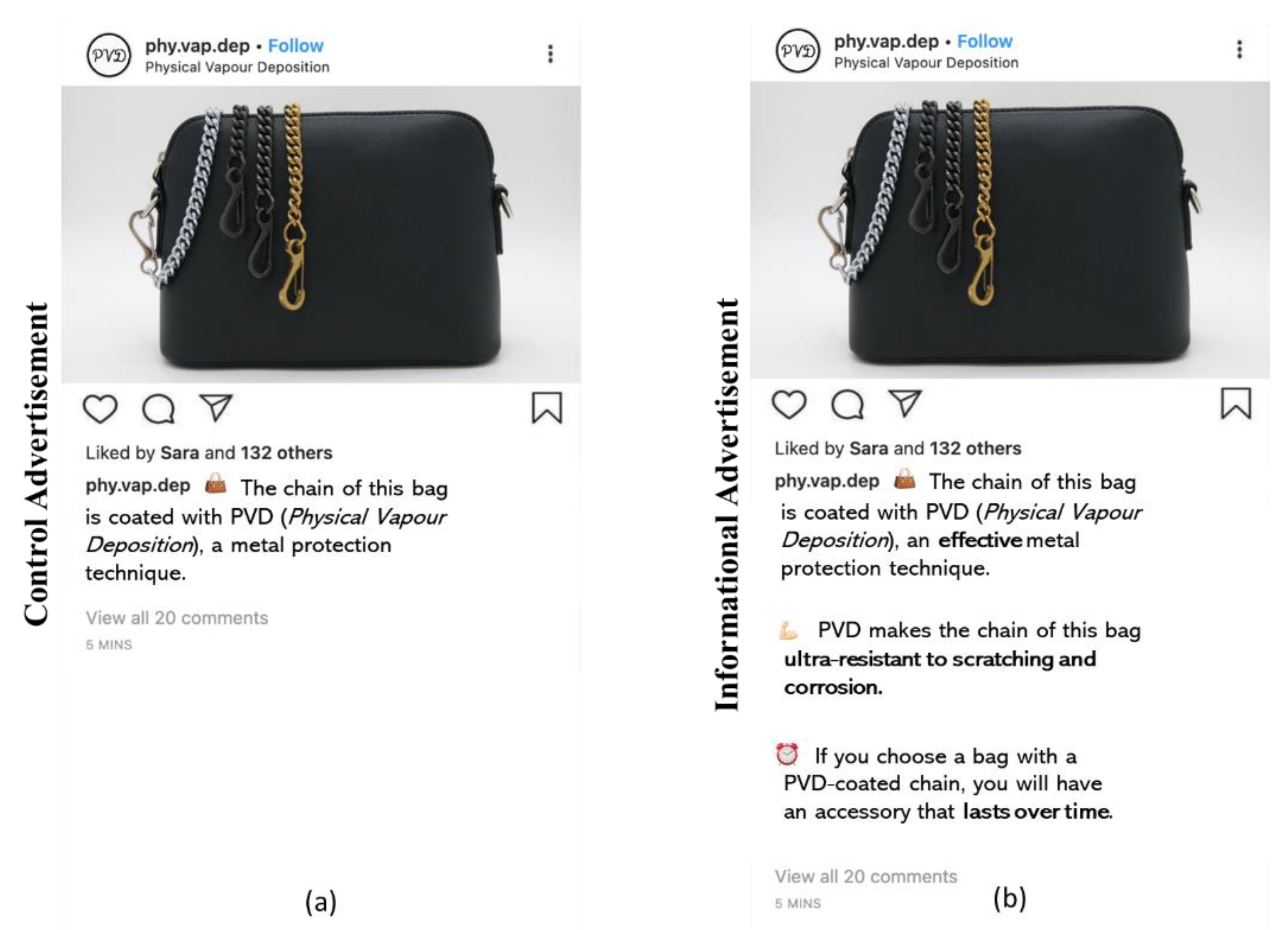
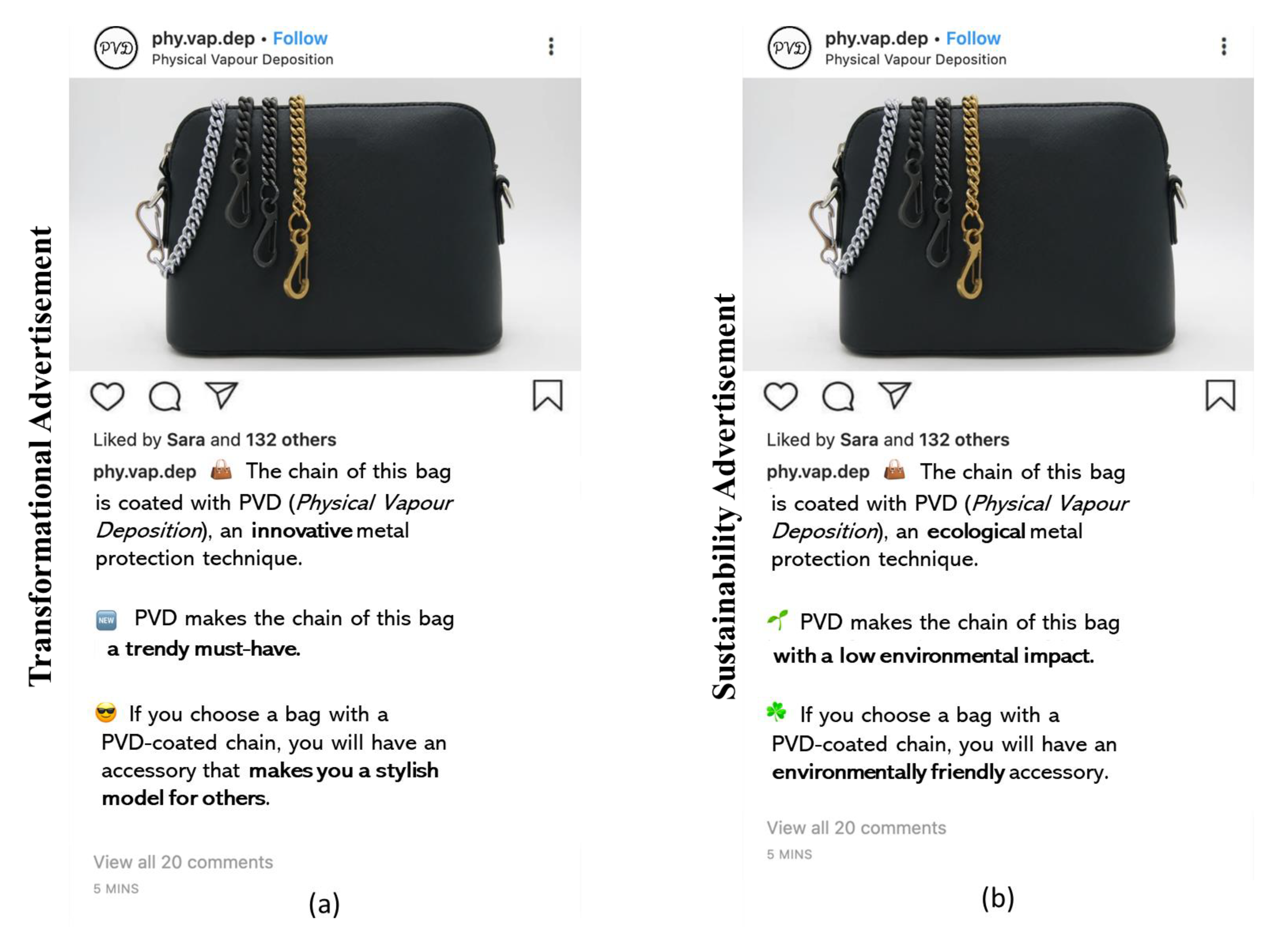
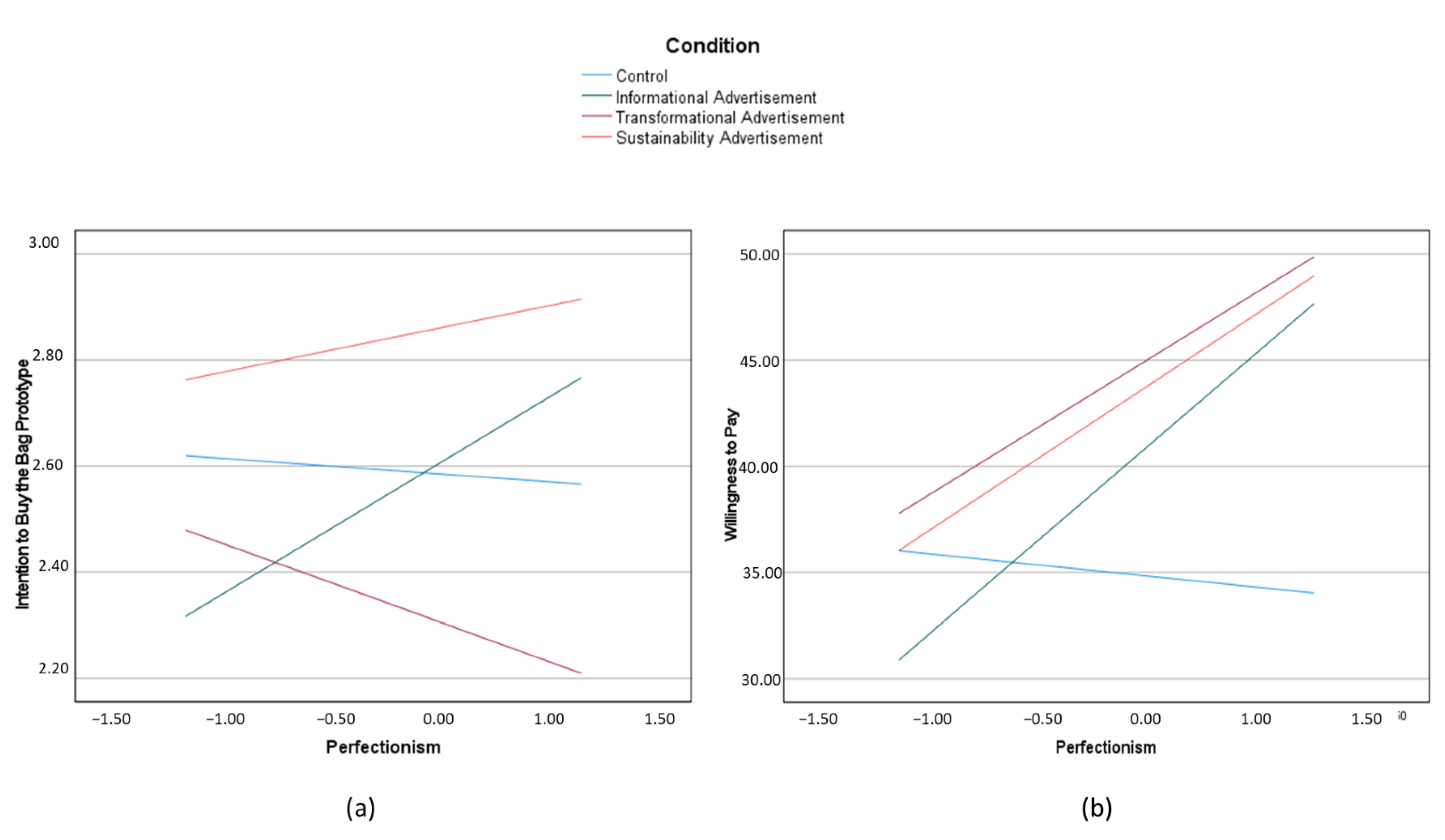
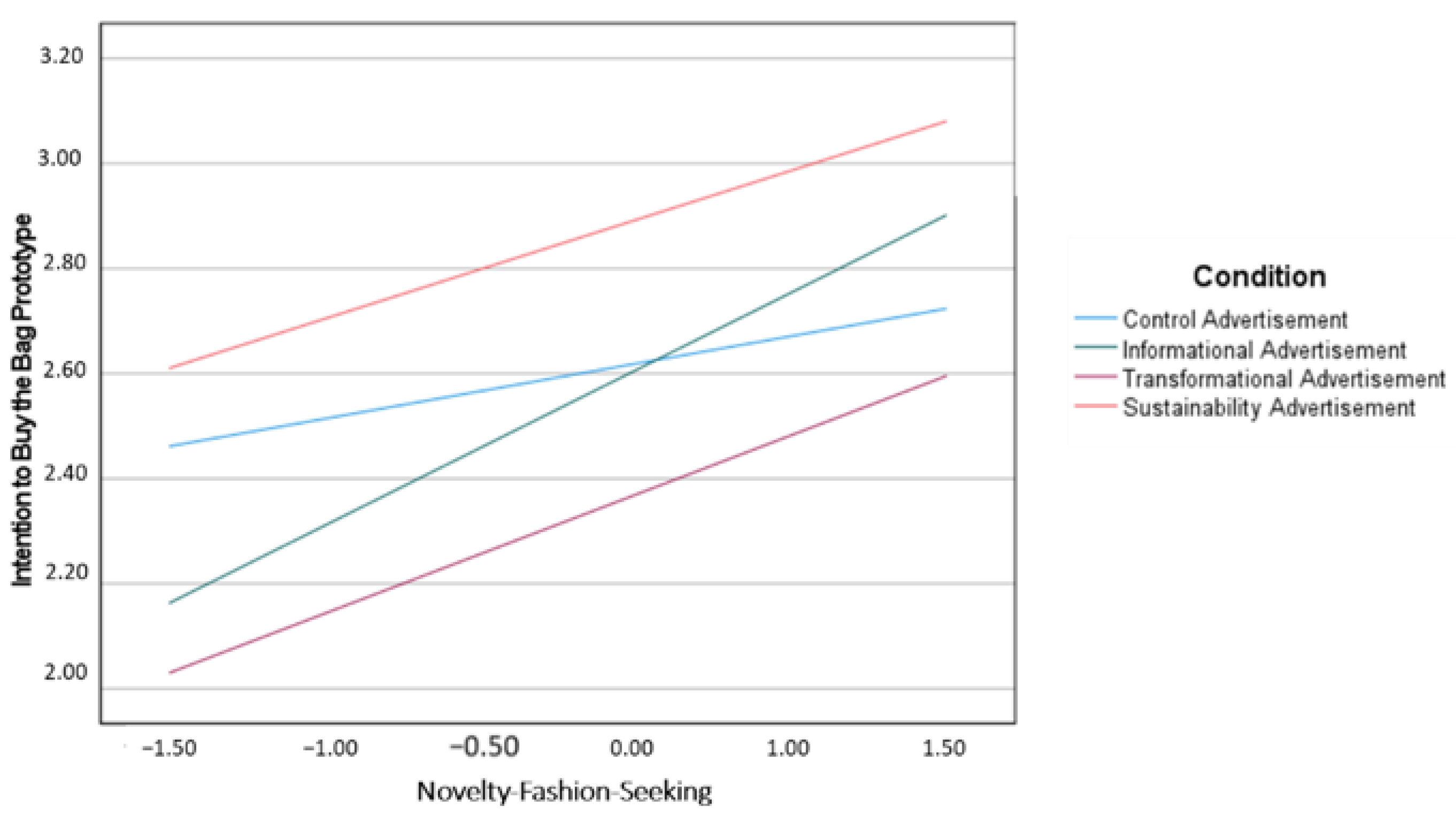
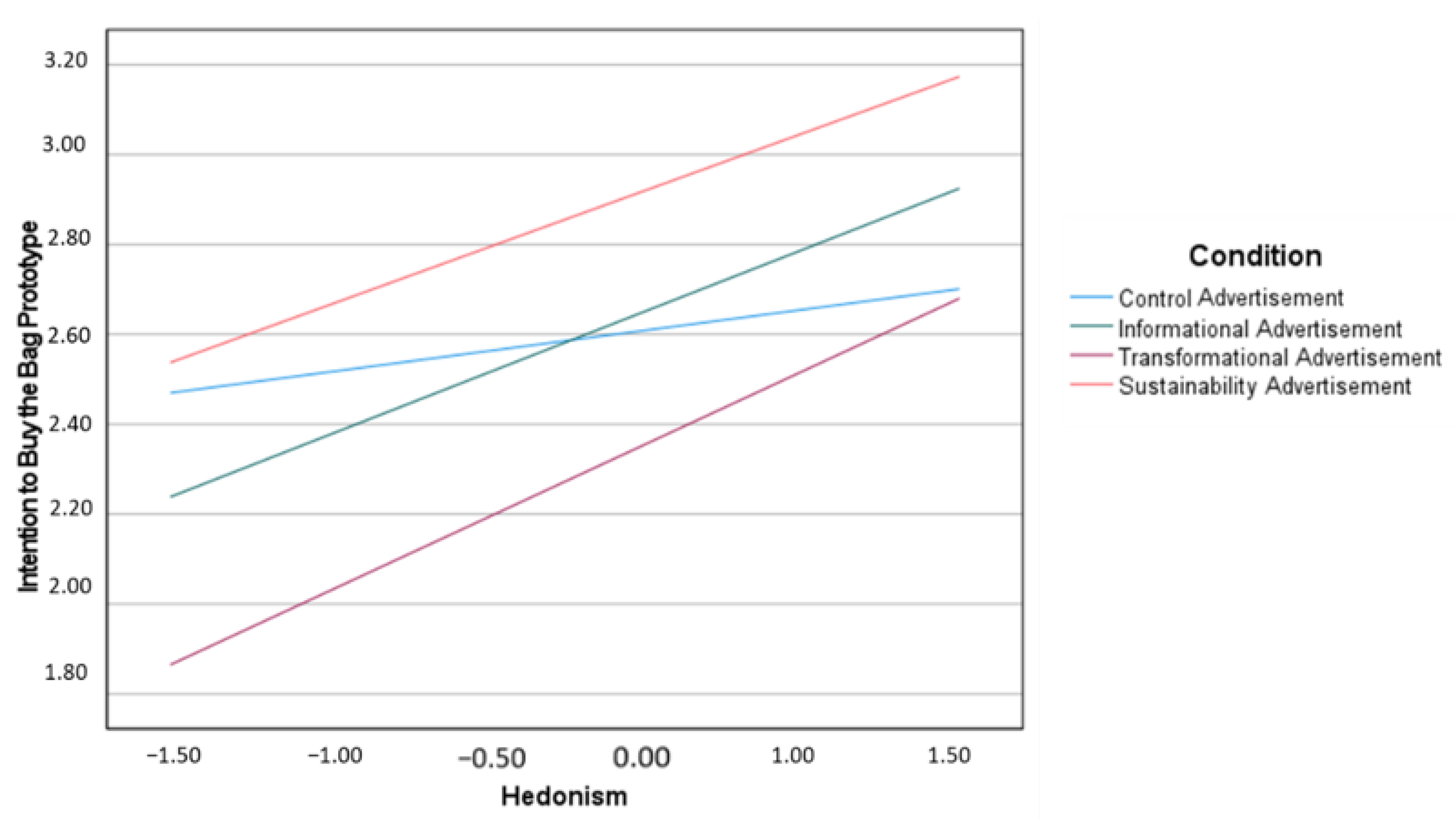
| % Total Sample | |
|---|---|
| Age | |
| 18–27 | 62.9 |
| 28–37 | 22.6 |
| 38–47 | 7.7 |
| 48–57 | 4.8 |
| 58–70 | 1.9 |
| Marital Status | |
| Single | 67.7 |
| Cohabiting Couple | 16.4 |
| Married | 10.3 |
| Separated/Divorced | 1.9 |
| Widow | 0.4 |
| Education | |
| Primary School | 0 |
| Secondary School | 1 |
| High School without Diploma | 1.5 |
| High School Diploma | 16.1 |
| University without Degree | 27.3 |
| University Degree | 27.7 |
| Monthly Income | |
| Low (up to 1200€) | 53.4 |
| Medium (1200–1800€) | 13.9 |
| High (more than 1801€) | 9.9 |
| Not Declared | 22.8 |
| Number of Residents in the Municipality of Residence | |
| Less than 10,000 | 16.1 |
| Between 10,000 and 30,000 | 23.2 |
| Between 30,000 and 100,000 | 23.4 |
| Between 100,000 and 250,000 | 10.1 |
| Between 250,000 and 500,000 | 3.9 |
| More than 500,000 | 23.4 |
| 1. | 2. | 3. | 4. | M | SD | |
|---|---|---|---|---|---|---|
| 1. Message Involvement | 1 | 4.01 | 1.35 | |||
| 2. Systematic Processing | 0.64 ** | 1 | 3.88 | 1.25 | ||
| 3. Intention | 0.59 ** | 0.43 ** | 1 | 2.58 | 1.00 | |
| 4. Willingness to Pay | 0.31 ** | 0.22 ** | 0.32 ** | 1 | 40.09 | 35.30 |
| Control Advertisement Condition(n = 129) | Informational Advertisement Condition(n = 129) | Emotional Advertisement Condition(n = 129) | Sustainability Advertisement Condition(n = 130) | |||||
|---|---|---|---|---|---|---|---|---|
| M | SD | M | SD | M | SD | M | SD | |
| Message Involvement | 3.63 | 1.25 | 4.09 | 1.35 | 3.60 | 1.34 | 4.73 | 1.15 |
| Systematic Processing | 3.60 | 1.26 | 3.88 | 1.25 | 3.71 | 1.25 | 4.32 | 1.12 |
| Intention to Buy | 2.60 | 0.86 | 2.55 | 1.14 | 2.33 | 0.99 | 2.82 | 0.95 |
| Willingness to Pay | 35.24 | 23.92 | 39.61 | 34.35 | 44.66 | 51.26 | 40.83 | 24.37 |
| Dependent Variable | Condition | Condition | Mean Difference |
|---|---|---|---|
| Message involvement | Informational Advertisement | Control Advertisement | 0.46 * |
| Emotional Advertisement | 0.48 * | ||
| Sustainability Advertisement | −0.64 ** | ||
| Emotional Advertisement | Control Advertisement | −0.02 | |
| Informational Advertisement | −0.48 * | ||
| Sustainability Advertisement | −1.13 ** | ||
| Sustainability Advertisement | Control Advertisement | 1.10 ** | |
| Informational Advertisement | 0.64 ** | ||
| Emotional Advertisement | 1.13 ** | ||
| Systematic Processing | Informational Advertisement | Control Advertisement | 0.28 |
| Emotional Advertisement | 0.17 | ||
| Sustainability Advertisement | −0.44 * | ||
| Emotional Advertisement | Control Advertisement | 0.11 | |
| Informational Advertisement | −0.17 | ||
| Sustainability Advertisement | −0.61 ** | ||
| Sustainability Advertisement | Control Advertisement | 0.72 ** | |
| Informational Advertisement | 0.44 * | ||
| Emotional Advertisement | 0.61 ** | ||
| Intention to Buy | Informational Advertisement | Control Advertisement | −0.05 |
| Emotional Advertisement | 0.22 | ||
| Sustainability Advertisement | −0.27 | ||
| Emotional Advertisement | Control Advertisement | −0.28 | |
| Informational Advertisement | −0.22 | ||
| Sustainability Advertisement | −0.50 ** | ||
| Sustainability Advertisement | Control Advertisement | 0.22 | |
| Informational Advertisement | 0.27 | ||
| Emotional Advertisement | 0.50 ** | ||
| Willingness to Pay | Informational Advertisement | Control Advertisement | 4.37 |
| Emotional Advertisement | −5.05 | ||
| Sustainability Advertisement | −1.22 | ||
| Emotional Advertisement | Control Advertisement | 9.42 | |
| Informational Advertisement | 5.05 | ||
| Sustainability Advertisement | 3.83 | ||
| Sustainability Advertisement | Control Advertisement | 5.59 | |
| Informational Advertisement | 1.22 | ||
| Emotional Advertisement | −3.83 |
| Relative Conditional Indirect Effects of Conditions on Intention to Buy | Indexes of the Moderated Mediations | Relative Conditional Indirect Effects of Conditions on Willingness to Pay | Indexes of the Moderated Mediations | |||||
|---|---|---|---|---|---|---|---|---|
| Low Perfectionism | Medium Perfectionism | High Perfectionism | Low Perfectionism | Medium Perfectionism | High Perfectionism | |||
| Informational Advertisement Condition | ||||||||
| Message Involvement | −0.01 (95% CI = −0.16, 0.14) | 0.13 * (95% CI = 0.03, 0.24) | 0.30 * (95% CI = 0.13, 0.50) | 0.14 * (95% CI = 0.03, 0.26) | −0.14 (95% CI = −4.00, 3.41) | 3.26 * (95% CI = 0.79, 6.35) | 2.71 * (95% CI = 2.91, 13.58) | 3.40 * (95% CI = 0.72, 6.93) |
| Systematic Processing | 0.00 (95% CI = −0.03, 0.04) | 0.02 (95% CI = −0.00, 0.05) | 0.03 (95% CI = −0.00, 0.10) | 0.01 (95% CI = −0.01, 0.05) | 0.02 (95% CI = −0.78, 0.88) | 0.15 (95% CI = −0.67, 1.08) | 0.31 (95% CI = −1.37, 2.04) | 0.13 (95% CI = −0.64, 1.05) |
| Emotional Advertisement Condition | ||||||||
| Message Involvement | −0.05 (95% CI = −0.20, 0.11) | −0.01 (95% CI = −0.11, 0.09) | 0.04 (95% CI = −0.11, 0.20) | 0.04 (95% CI = −0.06, 0.15) | −0.12 (95% CI = −5.61, 2.56) | −0.22 (95% CI = −2.80, 2.26) | 1.04 (95% CI = −2.64, 5.22) | 1.01 (95% CI = −1.55, 4.05) |
| Systematic Processing | 0.00 (95% CI = −0.04, 0.04) | 0.00 (95% CI = −0.02, 0.03) | 0.01 (95% CI = −0.02, 0.06) | 0.00 (95% CI = −0.02, 0.03) | 0.00 (95% CI = −0.71, 0.81) | 0.05 (95% CI = −0.45, 0.62) | 0.11 (95% CI = −0.85, 1.08) | 0.05 (95% CI = −0.55, 0.63) |
| Sustainability Advertisement Condition | ||||||||
| Message Involvement | 0.24 * (95% CI = 0.11, 0.39) | 0.34 * (95% CI = 0.23, 0.48) | 0.49 * (95% CI = 0.30, 0.70) | 0.12 * (95% CI = 0.01, 0.22) | 5.88 * (95% CI = 1.41, 10.59) | 8.61 * (95% CI = 4.93, 13.29) | 12.02 * (95% CI = 6.51, 18.90) | 2.72 * (95% CI = 0.34, 5.65) |
| Systematic Processing | 0.04 (95% CI = −0.00, 0.11) | 0.05 (95% CI = −0.00, 0.11) | 0.06 (95% CI = −0.01, 0.14) | 0.01 (95% CI = −0.02, 0.03) | 0.37 (95% CI = −1.43, 2.39) | 0.43 (95% CI = −1.60, 2.55) | 0.52 (95% CI = −2.00, 3.19) | 0.07 (95% CI = −0.50, 0.75) |
| Relative Conditional Indirect Effects of Conditions on Intention to Buy | Indexes of the Moderated Mediations | Relative Conditional Indirect Effects of Conditions on Willingness to Pay | Indexes of the Moderated Mediations | |||||
|---|---|---|---|---|---|---|---|---|
| Low Novelty-Fashion Consciousness | Medium Novelty-Fashion Consciousness | High Novelty-Fashion Consciousness | Low Novelty-Fashion Consciousness | Medium Novelty-Fashion Consciousness | High Novelty-Fashion Consciousness | |||
| Informational Advertisement Condition | ||||||||
| Message Involvement | 0.01 (95% CI = −0.11, 0.14) | 0.12 * (95% CI = 0.03, 0.23) | 0.27 * (95% CI = 0.10, 0.45) | 0.08 * (95% CI = 0.01, 0.16) | 0.24 (95% CI = −2.86, 3.79) | 3.06 * (95% CI = 0.76, 6.12) | 6.59 * (95% CI = 2.55, 11.88) | 2.11 * (95% CI = 0.36, 4.28) |
| Systematic Processing | 0.01 (95% CI = −0.03, 0.04) | 0.02 (95% CI = −0.00, 0.05) | 0.03 (95% CI = −0.01, 0.09) | 0.01 (95% CI = −0.01, 0.03) | 0.06 (95% CI = −0.72, 0.89) | 0.14 (95% CI = −0.64, 1.09) | 0.25 (95% CI = −1.04, 1.91) | 0.06 (95% CI = −0.37, 0.68) |
| Emotional Advertisement Condition | ||||||||
| Message Involvement | −0.11 (95% CI = −0.24, 0.01) | −0.02 (95% CI = −0.11, 0.07) | 0.10 (95% CI = −0.02, 0.23) | 0.07 (95% CI = −0.00, 0.14) | −2.82 (95% CI = −6.49, 0.53) | −0.51 (95% CI = −2.98, 1.80) | 2.38 (95% CI = −1.29, 6.59) | 1.73 * (95% CI = 0.01, 3.70) |
| Systematic Processing | 0.01 (95% CI = −0.03, 0.05) | 0.01 (95% CI = −0.02, 0.03) | 0.01 (95% CI = −0.03, 0.05) | 0.00 (95% CI = −0.02, 0.03) | 0.00 (95% CI = −2.10, 3.49) | 0.06 (95% CI = −1.60, 2.53) | 0.06 (95% CI = −1.09, 1.78) | 0.00 (95% CI = −0.43, 0.50) |
| Sustainability Advertisement Condition | ||||||||
| Message Involvement | 0.33 * (95% CI = 0.07, 0.48) | 0.34 * (95% CI = 0.23, 0.47) | 0.36 * (95% CI = 0.19, 0.55) | 0.01 (95% CI = −0.06, 0.08) | 8.11 * (95% CI = 4.21, 13.57) | 8.23 * (95% CI = 4.71, 13.17) | 8.83 * (95% CI = 4.20, 14.57) | 0.24 (95% CI = −1.47, 2.04) |
| Systematic Processing | 0.06 (95% CI = −0.01, 0.15) | 0.05 (95% CI = −0.00, 0.11) | 0.03 (95% CI = −0.01, 0.08) | −0.01 (95% CI = −0.04, 0.00) | 0.56 (95% CI = −2.10, 3.49) | 0.42 (95% CI = −1.60, 2.54) | 0.23 (95% CI = −2.10, 3.49) | −0.11 (95% CI = −0.86, 0.50) |
| Relative Conditional Indirect Effects of Conditions on Intention to Buy | Indexes of the Moderated Mediations | Relative Conditional Indirect Effects of Conditions on Willingness to Pay | Indexes of the Moderated Mediations | |||||
|---|---|---|---|---|---|---|---|---|
| Low Hedonism | Medium Hedonism | High Hedonism | Low Hedonism | Medium Hedonism | High Hedonism | |||
| Informational Advertisement Condition | ||||||||
| Message Involvement | 0.05 (95% CI = −0.10, 0.20) | 0.17 * (95% CI = 0.07, 0.28) | 0.25 * (95% CI = 0.10, 0.43) | 0.05 * (95% CI = 0.01, 0.15) | 1.28 (95% CI = −2.43, 5.27) | 4.20 * (95% CI = 1.59, 7.53) | 6.14 * (95% CI = 2.13, 11.25) | 1.46 (95% CI = −0.24, 3.45) |
| Systematic Processing | 0.02 (95% CI = −0.01, 0.07) | 0.02 (95% CI = −0.01, 0.07) | 0.02 (95% CI = −0.00, 0.06) | 0.00 (95% CI = −0.02, 0.02) | 0.19 (95% CI = −0.98, 1.49) | 0.19 (95% CI = −0.75, 1.26) | 0.19 (95% CI = −0.79, 1.54) | −0.00 (95% CI = −0.34, 0.42) |
| Emotional Advertisement Condition | ||||||||
| Message Involvement | −0.14 (95% CI = −0.32, 0.01) | −0.01 (95% CI = −0.11, 0.09) | 0.08 (95% CI = −0.06, 0.23) | 0.07 (95% CI = −0.00, 0.14) | −3.49 (95% CI = −8.20, 0.62) | −0.24 (95% CI = −2.63, 2.10) | 1.98 (95% CI = −1.64, 5.85) | 1.62 (95% CI = −0.23, 3.71) |
| Systematic Processing | 0.08 (95% CI = −0.01, 0.17) | 0.04 (95% CI = −0.00, 0.10) | 0.02 (95% CI = −0.01, 0.07) | −0.01 (95% CI = −0.04, 0.00) | 0.14 (95% CI = −0.90, 1.40) | 0.05 (95% CI = −0.43, 0.61) | −0.01 (95% CI = −0.80, 0.74) | −0.04 (95% CI = −0.58, 0.39) |
| Sustainability Advertisement Condition | ||||||||
| Message Involvement | 0.35 * (95% CI = 0.19, 0.52) | 0.35 * (95% CI = 0.23, 0.48) | 0.35 * (95% CI = 0.19, 0.53) | 0.00 (95% CI = −0.06, 0.07) | 8.58 * (95% CI = 4.09, 14.32) | 8.58 * (95% CI = 4.63, 13.21) | 8.58 * (95% CI = 4.33, 13.91) | −0.00 (95% CI = −1.75, 1.70) |
| Systematic Processing | 0.08 (95% CI = −0.01, 0.10) | 0.04 (95% CI = −0.00, 0.10) | 0.02 (95% CI = −0.00, 0.07) | −0.02 (95% CI = −0.04, 0.00) | 0.67 (95% CI = −2.42 3.96) | 0.39 (95% CI = −1.40, 2.29) | 0.20 (95% CI = −0.86, 1.4) | −0.14 (95% CI = −1.00, 0.55) |
| Relative Conditional Indirect Effects of Conditions on Intention to Buy | Indexes of the Moderated Mediations | Relative Conditional Indirect Effects of Conditions on Willingness to Pay | Indexes of the Moderated Mediations | |||||
|---|---|---|---|---|---|---|---|---|
| Low Green Consumerism | Medium Green Consumerism | High Green Consumerism | Low Green Consumerism | Medium Green Consumerism | High Green Consumer | |||
| Informational Message Condition | ||||||||
| Message Involvement | 0.09 (95% CI = −0.06, 0.26) | 0.13 * (95% CI = 0.03, 0.25) | 0.17 * (95% CI = 0.05; 0.31) | 0.04 (95% CI = −0.05, 0.13) | 2.01 (95% CI = −2.73, 6.86) | 3.61 * (95% CI = 0.59, 7.12) | 5.21 * (95% CI = 1.43, 9.99) | 1.03 (95% CI = −1.30, 3.46) |
| Systematic Processing | 0.02 (95% CI = −0.01, 0.08) | 0.02 (95% CI = −0.00, 0.06) | 0.02 (95% CI = −0.01, 0.06) | −0.00 (95% CI = −0.03, 0.02) | 0.19 (95% CI = −0.93, 1.65) | 0.16 (95% CI = −0.74, 1.22) | 0.14 (95% CI = −0.75, 1.08) | −0.02 (95% CI = −0.63, 0.39) |
| Emotional Message Condition | ||||||||
| Message Involvement | −0.08 (95% CI = −0.21, 0.06) | −0.06 (95% CI = −0.10, 0.10) | 0.06 (95% CI = −0.06, 0.20) | 0.07 (95% CI = −0.02, 0.16) | −1.87 (95% CI = −5.64, 1.53) | −0.16 (95% CI = −2.77, 2.29) | 1.60 (95% CI = −1.59, 5.17) | 1.70 (95% CI = −0.41, 4.16) |
| Systematic Processing | 0.00 (95% CI = −0.03, 0.04) | 0.01 (95% CI = −0.01, 0.04) | 0.02 (95% CI = −0.01, 0.06) | 0.01 (95% CI = −0.01, 0.04) | 0.03 (95% CI = −0.60, 0.88) | 0.10 (95% CI = −0.54, 0.92) | 0.17 (95% CI = −0.89, 1.34) | 0.07 (95% CI = −0.51, 0.67) |
| Sustainability Message Condition | ||||||||
| Message Involvement | 0.24 * (95% CI = 0.11, 0.41) | 0.34 * (95% CI = 0.23, 0.47) | 0.43 * (95% CI = 0.28, 0.61) | 0.09 * (95% CI = 0.01, 0.19) | 6.05 * (95% CI = 2.45, 10.67) | 8.34 * (95% CI = 4.66, 12.90) | 10.72 * (95% CI = 5.71, 16.80) | 2.29 (95% CI = −0.15, 5.06) |
| Systematic Processing | 0.04 * (95% CI = 0.01, 0.11) | 0.05 * (95% CI = 0.01, 0.11) | 0.06 * (95% CI = 0.01, 0.14) | 0.01 * (95% CI = 0.01, 0.04) | 0.33 (95% CI = −1.25, 2.36) | 0.44 (95% CI = −1.61, 2.66) | 0.56 (95% CI = −2.08, 3.26) | 0.11 (95% CI = −0.58, 0.78) |
Publisher’s Note: MDPI stays neutral with regard to jurisdictional claims in published maps and institutional affiliations. |
© 2022 by the authors. Licensee MDPI, Basel, Switzerland. This article is an open access article distributed under the terms and conditions of the Creative Commons Attribution (CC BY) license (https://creativecommons.org/licenses/by/4.0/).
Share and Cite
Carfora, V.; Catellani, P. Advertising Innovative Sustainable Fashion: Informational, Transformational, or Sustainability Appeal? Sustainability 2022, 14, 16148. https://doi.org/10.3390/su142316148
Carfora V, Catellani P. Advertising Innovative Sustainable Fashion: Informational, Transformational, or Sustainability Appeal? Sustainability. 2022; 14(23):16148. https://doi.org/10.3390/su142316148
Chicago/Turabian StyleCarfora, Valentina, and Patrizia Catellani. 2022. "Advertising Innovative Sustainable Fashion: Informational, Transformational, or Sustainability Appeal?" Sustainability 14, no. 23: 16148. https://doi.org/10.3390/su142316148
APA StyleCarfora, V., & Catellani, P. (2022). Advertising Innovative Sustainable Fashion: Informational, Transformational, or Sustainability Appeal? Sustainability, 14(23), 16148. https://doi.org/10.3390/su142316148









